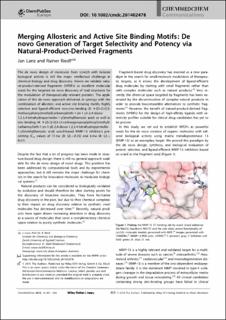Bitte benutzen Sie diese Kennung, um auf die Ressource zu verweisen:
https://doi.org/10.21256/zhaw-1687| Publikationstyp: | Beitrag in wissenschaftlicher Zeitschrift |
| Art der Begutachtung: | Peer review (Publikation) |
| Titel: | Merging allosteric and active site binding motifs : de novo generation of target selectivity and potency via natural-product-derived fragments |
| Autor/-in: | Lanz, Jan Riedl, Rainer |
| DOI: | 10.1002/cmdc.201402478 10.21256/zhaw-1687 |
| Erschienen in: | ChemMedChem |
| Band(Heft): | 10 |
| Heft: | 3 |
| Seite(n): | 451 |
| Seiten bis: | 454 |
| Erscheinungsdatum: | 2015 |
| Verlag / Hrsg. Institution: | Wiley |
| ISSN: | 1860-7187 1860-7179 |
| Sprache: | Englisch |
| Schlagwörter: | Medicinal chemistry; De novo drug design |
| Fachgebiet (DDC): | 572: Biochemie 615: Pharmakologie und Therapeutik |
| Zusammenfassung: | The de novo design of molecules from scratch with tailored biological activity is still the major intellectual challenge in chemical biology and drug discovery. Herein we validate natural-product-derived fragments (NPDFs) as excellent molecular seeds for the targeted de novo discovery of lead structures for the modulation of therapeutically relevant proteins. The application of this de novo approach delivered, in synergy with the combination of allosteric and active site binding motifs, highly selective and ligand-efficient non-zinc-binding (3: 4-{[5-(2-{[(3-methoxyphenyl)methyl]carbamoyl}eth-1-yn-1-yl)-2,4-dioxo-1,2,3,4-tetrahydropyrimidin-1-yl]methyl}benzoic acid) as well as zinc-binding (4: 4-({5-[2-({[3-(3-carboxypropoxy)phenyl]methyl}carbamoyl)eth-1-yn-1-yl]-2,4-dioxo-1,2,3,4-tetrahydropyrimidin-1-yl}methyl)benzoic acid) uracil-based MMP-13 inhibitors presenting IC50 values of 11 nM (3: LE=0.35) and 6 nM (4: LE=0.31). |
| Weitere Angaben: | Coverpicture: https://doi.org/10.1002/cmdc.201590003 |
| URI: | https://digitalcollection.zhaw.ch/handle/11475/2862 |
| Volltext Version: | Publizierte Version |
| Lizenz (gemäss Verlagsvertrag): | CC BY-NC-ND 4.0: Namensnennung - Nicht kommerziell - Keine Bearbeitungen 4.0 International |
| Departement: | Life Sciences und Facility Management |
| Enthalten in den Sammlungen: | Publikationen Life Sciences und Facility Management |
Dateien zu dieser Ressource:
| Datei | Beschreibung | Größe | Format | |
|---|---|---|---|---|
| 2015_Lanz_Merging allosteric and active site binding motifs_ChemMedChem.pdf | 726.94 kB | Adobe PDF |  Öffnen/Anzeigen |
Zur Langanzeige
Lanz, J., & Riedl, R. (2015). Merging allosteric and active site binding motifs : de novo generation of target selectivity and potency via natural-product-derived fragments. ChemMedChem, 10(3), 451–454. https://doi.org/10.1002/cmdc.201402478
Lanz, J. and Riedl, R. (2015) ‘Merging allosteric and active site binding motifs : de novo generation of target selectivity and potency via natural-product-derived fragments’, ChemMedChem, 10(3), pp. 451–454. Available at: https://doi.org/10.1002/cmdc.201402478.
J. Lanz and R. Riedl, “Merging allosteric and active site binding motifs : de novo generation of target selectivity and potency via natural-product-derived fragments,” ChemMedChem, vol. 10, no. 3, pp. 451–454, 2015, doi: 10.1002/cmdc.201402478.
LANZ, Jan und Rainer RIEDL, 2015. Merging allosteric and active site binding motifs : de novo generation of target selectivity and potency via natural-product-derived fragments. ChemMedChem. 2015. Bd. 10, Nr. 3, S. 451–454. DOI 10.1002/cmdc.201402478
Lanz, Jan, and Rainer Riedl. 2015. “Merging Allosteric and Active Site Binding Motifs : De Novo Generation of Target Selectivity and Potency via Natural-Product-Derived Fragments.” ChemMedChem 10 (3): 451–54. https://doi.org/10.1002/cmdc.201402478.
Lanz, Jan, and Rainer Riedl. “Merging Allosteric and Active Site Binding Motifs : De Novo Generation of Target Selectivity and Potency via Natural-Product-Derived Fragments.” ChemMedChem, vol. 10, no. 3, 2015, pp. 451–54, https://doi.org/10.1002/cmdc.201402478.
Alle Ressourcen in diesem Repository sind urheberrechtlich geschützt, soweit nicht anderweitig angezeigt.